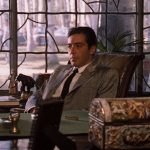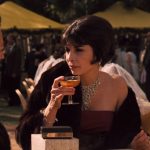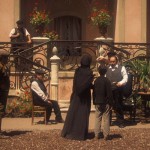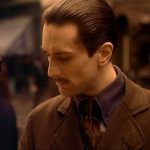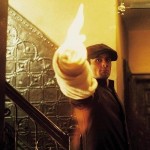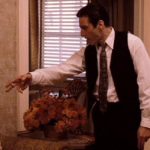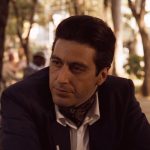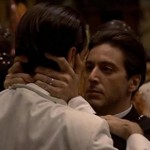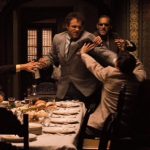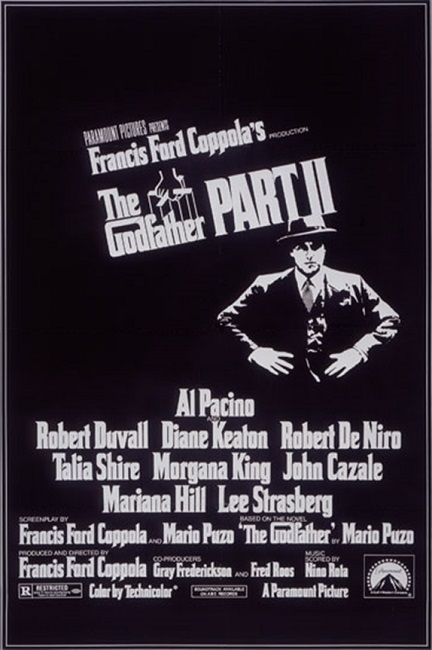
The Godfather Part II – 1974
Al Pacino, Robert Duvall, Talia Shire, John Cazale, and Diane Keaton return for the second installment of the Godfather saga. This time they are joined by another name that is pretty big today, Robert De Niro, along with Lee Strasberg and Michael V. Gazzo.
A good way to start is by giving a little information about the nature of sequels, based on my own observations. First is the general opinion that a sequel is rarely as good as its predecessor. I think that this is because a sequel usually tries to top whatever made the first film popular, but it usually tries too hard and ends up failing. Either that, or it just gives the audience more of the same thing, making them say, “We’ve seen this all before.” Second is that if one sequel is made, it is a good indication that they plan to make at least one more film after that. In other words, serious filmmakers rarely stop at just two installments without going for number three.
The Godfather Part II does a good job of bucking both of these conventions. Instead of trying to top all the excessive violence and Italian Mafia stereotypes that made the first one so popular, Director Francis Ford Coppola chose to continue the story, concentrating more on character development, plot development, and emotional drama. He made it a different kind of film that was good standing on its own two feet, rather than standing on the shoulders of Part I.
And as for setting the audience up for The Godfather Part III, I’m not so sure it did that. The ending seemed to complete the story. Sure, more plot can always be written and told, but the film had the feeling of closure. Now, it just so happens that Coppola eventually did end up making a third Godfather movie, but it was 16 years later and is widely regarded as the weakest film in the trilogy. I could forego seeing the next film, and I’d still be satisfied with the way it ended.
The main plot picks up where the last one left off. Michael Corleone (Pacino) is now the head of the crime family, though he is making a half-hearted effort to go legit. He wife Kay is aware of the criminal activities of her husband’s family, and encourages him in his efforts to go straight. However, when Michael narrowly escapes an assassination attempt that also threatened the lives of his family, he goes out of his way to find out who was behind the attempt and get his revenge.
Then there is a wonderfully portrayed secondary plot which is told along-side the first. It is a flash-back, of sorts, that told the story of Vito Corleone from his early childhood in Sicily and his young adulthood in New York. From this, we see how he rose to his position of power as the Don of the Corleone family. The two stories are told simultaneously, switching back and forth between the two all the way through the film.
Pacino turned in an inspired performance. He was nominated for Best Actor that year and many consider it to be the greatest performance of his career. The cold ruthlessness with which he governs and protects his family was masterfully portrayed. One scene in particular that stood out to me is the scene in which his wife tries to leave him, telling him that she had not miscarried their child. She’d had an abortion, knowing that she was killing his unborn son. The barely contained fury that consumed him was frightening to watch. And when he exploded, I felt his anger along with him. Well done Pacino!
Interesting note: Even though his performance was considered one of the greatest performances in cinema history, he lost the Oscar to Art Carney for his role in Harry and Tonto, a film that very few people even remember today. (…meaning that I have never heard of it!)
Robert Duvall also returned with a good performance, though not much was really done with his character. The roles of the women were increased Keaton and Talia Shire who played the role of Michael’s sister Connie Corleone were both given more to do and more screen-time. Lee Strasberg played Michael’s main enemy Hyman Roth, a man who had been in business with his father, Vito, and who was ultimately behind the failed assassination attempt. His conspirators Frank Pentangeli, (Gazzo) amd Fredo Coreleon (Cazale), Michael’s older brother, also did a good job.
Interesting note: The actor Richard Castellano from the first Godfather film played the part of Peter Clemenza. The actor had a disagreement with Paramount Studios and did not return to reprise his role in the sequel. However, in the flashback sequences, the young Clemenza is played by an actor I always enjoy watching, Bruno Kirby. His character was actually supposed to be the one who turned against Michael Corleone, but instead he was replaced with the character of Frank Pentangeli.
All this was an engaging drama, but for me, the most interesting part of the film was the secondary plot about Vito Corleone’s rise to power. In the first Godfather film, Vito is the Don. He stands apart, controlling the violence and bloodshed, but keeping his own hands clean. But as one might expect he could not have realistically risen from the position of a poor immigrant to the head of a rich and prominent crime family without getting his fair share of dirt on his face and blood on his own hands.
De Niro did a terrific job as the young Vito Andolini, later named Corleone at Ellis Island. As a nine-year-old in Sicily, his father and brother are murdered by Don Ciccio, played by Giuseppe Sillato. When his mother takes him to the Don to ask that her son be spared the same fate, he refuses and murders her in front of him. Vito escapes and is smuggled to America. The next flashback shows him as a young man with a wife and children in New York. De Niro does a great job creating his own character while paying obvious homage to Marlon Brando’s character, making the fictional transition very easy to believe. It was a challenging role and De Niro really did it justice.
De Niro actually won the Best Supporting Actor Academy Award for his fantastic portrayal, and I think it was well deserved. As actors go, I have always preferred De Niro to Pacino. He can play the tough guy just as well, but he has a humanizing softness that Pacino often lacks.
And finally, I have to mention the final flashback. This was a little stroke of genius on Coppola’s part. There is a short scene at the end that runs for maybe five minutes that brought back actors James Caan, Gianni Russo, and Abe Vigoda. They are characters that did not survive the first film. It is a tiny scene that tells of Michael’s decision to join the Marines in the face of World War II. It is a masterful little piece of plot that ties the Godfather Part I to Part II very neatly.
Interesting note: Even though this little scene only took one day to film, James Caan only agreed to reprise his role if he received the same salary he’d made for The Godfather Part I. He got his way.
Another interesting note: Marlon Brando was supposed to have been in this scene as well, but he felt that he was being mistreated by the board at Paramount. He failed to show up for the one day shoot. Coppola had to rewrite the scene on the spot to exclude Vito. During the scene, you can hear him in another room, but the character never appears on the screen.
There is no doubt that this was a good movie. It was engaging and well written. But for me, it was never able to recapture the energy of the first film. Sure, it had its own feeling and style, a different kind of energy, but I ultimately enjoyed watching the first one more.
